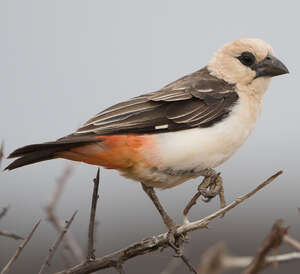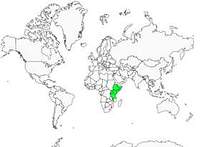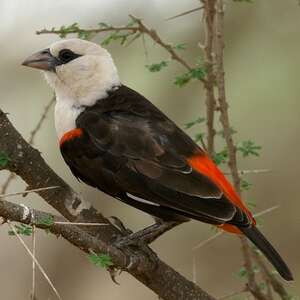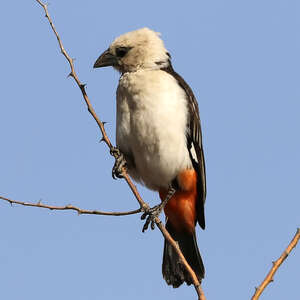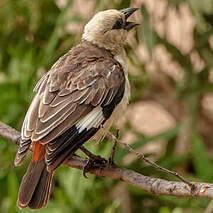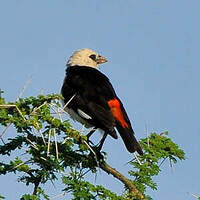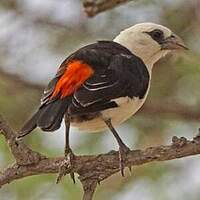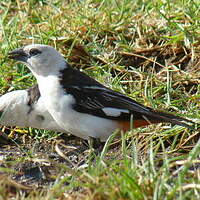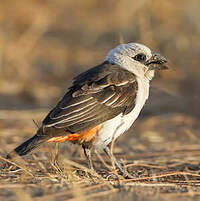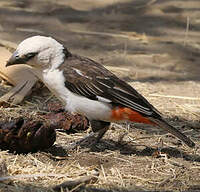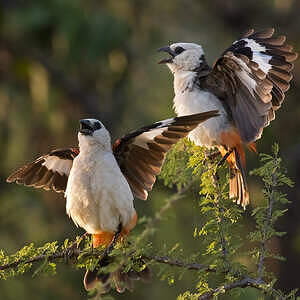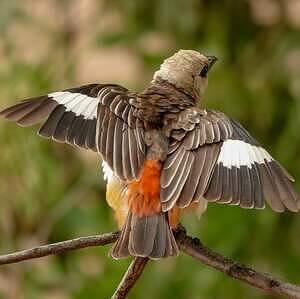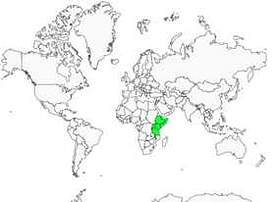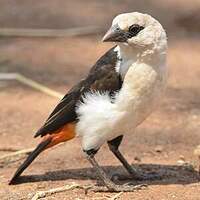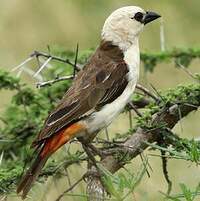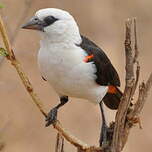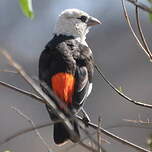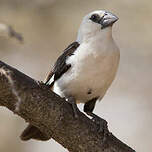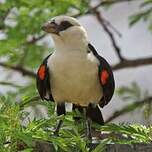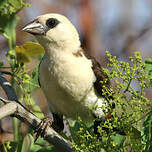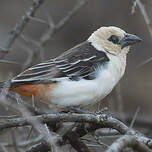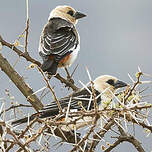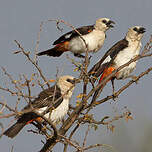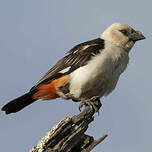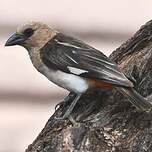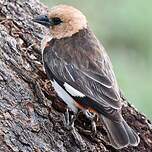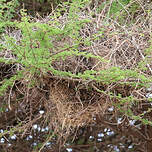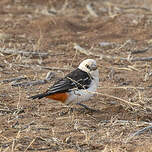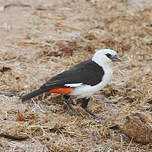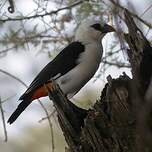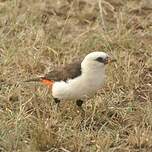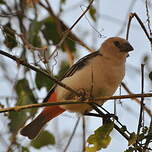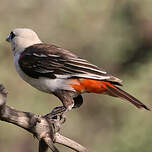White-headed Buffalo Weaver
Dinemellia dinemelli - Alecto à tête blanche
Identification
The White-headed Buffalo Weaver is like a large two-coloured sparrow. It is aptly named as the adult head is completely white. The dark eye is ringed with black and a black patch of skin connects it to the base of the black bill. The upper parts, mantle and back, are dark brown or black depending on the subspecies. The underside, from the chin to the belly, is white. The whole backside, rump, upper and lower tail coverts, are reddish-orange. The white head and body are usually tinged with rufous cream.
The wings and tail are black, some feathers edged with white, especially the scapulars and tertiaries. A white wingbar can be observed at the base of the primaries, clearly visible in flight. Reddish-orange shoulder patches, usually camouflaged, may sometimes be seen near the wrist of the wing.
The legs are grey. There is no sexual dimorphism.
The juvenile is similar to the adult, though the reddish-orange is paler and the bill is horn coloured.
The two subspecies can only be distinguished by the colour of the upperparts, brown in ssp. dinemelli, and black in boehmi.
Subspecific information 2 subspecies
- Dinemellia dinemelli dinemelli (se Sudan, Ethiopia and Somalia to Kenya. except se.)
- Dinemellia dinemelli boehmi (se Kenya and Tanzania)
Foreign names
- Alecto à tête blanche,
- Bufalero cabeciblanco,
- tecelão-de-cabeça-branca,
- Starweber,
- fehérfejű szövőmadár,
- Witkopbuffelwever,
- Tessitore dei bufali testabianca,
- vithuvad buffelvävare,
- Hvithodevever,
- byvoliar bielohlavý,
- snovač bělohlavý,
- Hvidhovedet Bøffelvæver,
- tuliperäkutoja,
- teixidor bufaler capblanc,
- bawolik białogłowy,
- Белоголовый скворцовый ткач,
- シロガシラウシハタオリ,
- 白头牛文鸟,
- vithuvad buffelvävare,
- 白頭牛文鳥,
Voice song and call
The White-headed Buffalo Weaver's song is a short sequence of 3-4 whistled notes, with themes like tsi tia tiu, tiu tiu kui kui, tsu-wili-wili-wir, with many variations. Sometimes the notes become nasal or sharp, reminiscent of a starling. The usual call is a drawn out and extended tiou, often repeated, as a contact call, especially when the group is foraging alongside other birds.
Habitat
The White-headed Buffalo Weaver can be seen from sea level up to 1,400 metres in East Africa and 1,900 metres in the horn of Africa. Its main habitat is savannah, semi-arid or dry, with shrubby areas, usually consisting of thorny bushes, acacias and scrub. It can rarely be found in neighbouring meadows, or in riparian vegetation.
Behaviour character trait
White-headed Buffalo Weavers are gregarious like many other Ploceidae. They can be seen, for example, cleaning themselves together at the top of a tree or bush.
They usually search for their food in groups, and often join with other species such as the magnificent Starlings. They can be seen, for example, around herds of African bison, looking for prey disturbed by the large herbivores.On the other hand, for reproduction, monogamous couples nest isolated or in small groups. They are territorial and defend their territory very demonstratively, but this rarely leads to aggression.
The species is resident, and only local movements are known.
Dietfeeding habits
The diet of the White-headed Buffalo Weaver is mixed. It mainly feeds on insects, such as beetles and larvae of lepidoptera which have been found in its stomach contents.
Its strong, conical bill also allows it to crack open seeds. Furthermore, fruits are also part of its diet.It typically forages for food on the ground in groups of three to six individuals, often in the company of other species, such as Superb Starlings or White-crested Sparrows in Somalia. Fruits may be taken directly from trees. In Kenya, groups of birds can be often seen foraging in open forests.
Reproduction nesting
The breeding season depends on local rainfall: August to September and December in Sudan, April to August in Ethiopia, February to June and September in Somalia, May in Uganda, February-March, May, July, and November in Kenya, and December in Tanzania. Very territorial, this bird is monogamous. Males seduce females, perched prominently on top of a bush to be most visible or simply on the ground, opening their wings to display red and white viral marks.
The male and female build the nest together. It is built 2 to 4 meters above the ground. It rests on a branch or is suspended at the end.
The first step in nesting is the construction of the chamber. It is composed of dry grass, leaves and feathers. All around the chamber, or chambers as there can be several, they add close but not intertwined twigs as weavers would do. Once completed, the nest is a large oval vegetable structure of more than 50 cm, externally protected by large thorns and equipped with an access tunnel opening downwards.
Old Mahalis nests can be reoccupied by Alectos. Conversely, the Alectos nest can be usurped by the African Falconet or Amadine Cut Throat, which will adjust the entrance of the nest to its size.
The female lays 3 to 5 gray or bluish pale eggs, roughly spotted with olive brown and grayish brown, and incubates them for 11 to 14 days. The chicks are fed by both parents with insects and seeds.
In captive Alectos, it has been noted that adult birds other than the parents can cooperate in feeding the young.This also allowed for the nestling period of the White-headed Buffalo Weaver to be set at 14 days.
Geographic range
Threats - protection
Sources of information
- IOC World Bird List (v15.1), Gill, F and D Donsker (Eds). 2025-12-07.
- Birds of East Africa, C.A.W. Guggisberg
- Avibase, Lepage Denis
- BirdLife International, BirdLife International
- Wikipedia (English version),
- HBW Alive,
Other sources of interest
 Specification sheet created on
21/07/2023 by Nathalie Santa Maria
Specification sheet created on
21/07/2023 by Nathalie Santa MariaTranslation by AI Oiseaux.net
© 1996-2025 Oiseaux.net
- Accipitriformes
- Aegotheliformes
- Anseriformes
- Apodiformes
- Apterygiformes
- Bucerotiformes
- Caprimulgiformes
- Cariamiformes
- Casuariiformes
- Charadriiformes
- Ciconiiformes
- Coliiformes
- Columbiformes
- Coraciiformes
- Cuculiformes
- Eurypygiformes
- Falconiformes
- Galliformes
- Gaviiformes
- Gruiformes
- Leptosomiformes
- Mesitornithiformes
- Musophagiformes
- Nyctibiiformes
- Opisthocomiformes
- Otidiformes
- Passeriformes
- Pelecaniformes
- Phaethontiformes
- Phoenicopteriformes
- Piciformes
- Podargiformes
- Podicipediformes
- Procellariiformes
- Psittaciformes
- Pterocliformes
- Rheiformes
- Sphenisciformes
- Steatornithiformes
- Strigiformes
- Struthioniformes
- Suliformes
- Tinamiformes
- Trogoniformes

